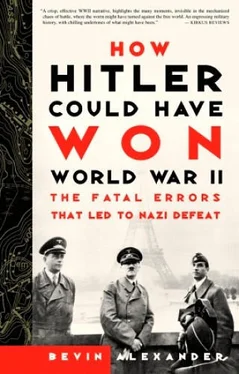In Africa and Sicily Anglo-American forces had seen elements of a new kind of close combat that the German army had developed in Russia. But on the boot of Italy they came firmly up against it. The Germans saw in Russia that infantry actions were fought overwhelmingly at close range, 75 yards or less, and introduced the MP38 and MP40 “Schmeisser” machine pistol that fired high-velocity pistol bullets, giving heavy unaimed fire to blanket an area and suppress enemy resistance. The Russians introduced a different sort of weapon that achieved the same effect, the PPSh41 7.62-millimeter submachine gun (burp gun). Supported by fast-firing portable machine guns, the MG-34 and MG-42, the Schmeissers gave Germans mobility and high volume of fire. They never replaced all their standard medium-range bolt-action rifles (the Mauser Kar. 98k) or employed many of the next-generation automatic assault rifles (Sturmgewehr), but Schmeissers and MG-34s and MG-42s gave them high capacity to defend against attacks.
The British replaced in part their medium-range bolt-action rifle, the Enfield No. 4, with various submachine guns (“Sten guns”) that fired the same 9-millimeter pistol cartridge as the Schmeisser, coupling them with the Bren gun, a reliable light machine gun. The Americans were slower to replace the M1 Garand semiautomatic medium-range rifle. Wherever possible they used the Thompson M1928 submachine gun, firing .45-caliber pistol ammunition, but this weapon was in short supply. Americans made do with their M1s, Browning Automatic Rifles (BARs), and light machine guns. It was late 1944 before they introduced the M3 submachine gun (grease gun) in large numbers to compete with the Schmeisser.
The Germans learned to exploit the weaknesses of Americans under fire for the first time. In such cases Americans had the tendency to freeze or to seek the nearest protection. All too often American infantry merely located and fixed the enemy, and called on artillery to destroy the defenders. Only after much experience in 1943 did American infantry learn that the best way to avoid losses was to keep moving forward and to close in rapidly on the enemy.
Tanks could not be used in the mountainous terrain of Italy in massed attacks as Rommel had done in Africa. In Italy tanks largely reverted to the infantry-support role that the British had envisioned for their Matildas and other “I” tanks at the start of the war. However, American tankers and infantry had little training in this role. Infantry and tanks could not communicate with each other. Infantry could not warn tankers of antitank traps and heavy weapons, and tankers could not alert infantry to enemy positions. Consequently, infantry had a tendency to lag behind tanks, and Americans did not work out the smooth coordination of tanks, infantry, and artillery that the Germans had developed long before in their battle groups or Kampfgruppen.
Similar problems developed in the use of tank destroyers (TDs), essentially 75-millimeter guns on open-topped tank chassis. TDs were designed to break up massed German panzer attacks. The Germans no longer massed tanks, but used them as parts of Kampfgruppen. American commanders slowly changed the use of TDs to assault guns to destroy enemy tanks and defensive positions with direct fire.
Finally, the Allies did a poor job of coordinating air-ground operations. Allied fighter-bomber pilots flying at 200 mph often could not distinguish between friendly and enemy forces on the ground. The pilots could not talk to ground units, and vice versa. This resulted in many cases of Allied aircraft bombing and strafing friendly forces. Consequently, Allied troops often fired on anything that moved in the sky. Only in the spring of 1944 did the U.S. Army Air Force deploy forward air controllers (FACs), using light single-engine liaison aircraft (L-5s) that could direct radio communication to aircraft and air-ground support parties at headquarters of major ground units. It was a bit late: the Germans had employed this system in the campaign in the west in 1940 to direct Stuka attacks on enemy positions.
The idea of restricting Allied efforts to southern Italy had been forgotten. Eisenhower set his sights on Rome in a November 8 directive, and was thinking of driving on up at least to Florence and Livorno (Leghorn).
Because of slow Allied progress up the peninsula, Hitler decided to make a prolonged stand in Italy. He dissolved Rommel’s army group in northern Italy, and gave Kesselring Rommel’s divisions—though he sent four of the best to Russia and replaced them with three depleted divisions that needed to recover.
Kesselring also got the 90th Panzergrenadier Division which Hitler had sent to Sardinia. It had withdrawn to Corsica when the Italians surrendered, then to Livorno. Kesselring rushed it to the east coast to help check Montgomery’s belated offensive, which finally developed on November 28.
Montgomery had been reinforced by the 2nd New Zealand Division, giving him five divisions and two armored brigades for the Sangro offensive. Meanwhile the Germans had formed 76th Panzer Corps to oppose 8th Army. This corps had received 65th Infantry Division, a raw and ill-equipped force of mixed nationalities, replacing 16th Panzer Division, being sent to Russia. Otherwise, the corps had only remnants of 1st Parachute Division and 26th Panzer Division, which was still en route to the Adriatic coast.
Montgomery intended to smash the Sangro line, drive to Pescara, get astride the highway to Rome, and threaten the rear of German forces holding up 5th Army.
The attack started under cover of an immense air and artillery bombardment. Montgomery had five soldiers to Kesselring’s one, and 65th Division gave way, withdrawing behind the Sangro to the main line farther back. Here the division held on firmly, giving 26th Panzer and 90th Panzergrenadier Divisions time to come up. These reinforcements slowed the British to a crawl. It took till December 10 to cross the Moro River, eight miles on, and until December 28 for Canadians to clear Ortona, two miles beyond the Moro. Montgomery was checked at Ricco, halfway to Pescara. He had been forced into a stalemate by the end of the year, when he gave up his command to Oliver Leese, and returned to England to take over 21st Army Group in preparation for the cross-Channel invasion of Normandy.
Mark Clark’s 5th Army had risen to ten divisions, but two of them, the British 7th Armored and the U.S. 82nd Airborne, were being withdrawn for the Normandy invasion. Kesselring now had four divisions facing Clark, with one in reserve.
Clark’s offensive started on December 2, aiming to crack—in a headlong attack—the mountain barrier west of Route 6 and the Mignano Gap. He used 10th Corps and the new U.S. 2nd Corps under Geoffrey Keyes. In heavy attacks, supported by massive artillery bombardment, the Allies made some progress, but at heavy cost. By the second week of January 1944 the offensive had petered out, still short of the Rapido River and the forward edge of the Gustav line. Losses had risen almost to 40,000, far exceeding German casualties, plus 50,000 Americans who had become sick in the cold and wet struggle in the mountains.
Marshal Kesselring had the most insightful comment on Allied leadership in Italy:
The Allied high command’s dominating thought was to make sure of success, a thought that led it to use orthodox methods and material. As a result it was almost always possible for me, despite inadequate means of reconnaissance and scanty reports, to foresee the next strategic or tactical move of my opponent.
By January 1944 Italy was already a secondary theater. German and western Allied attention was turning toward a direct confrontation on the beaches of northern France in the spring.
The Teheran conference between Churchill, Roosevelt, and Stalin in November 1943, immediately preceded by the Anglo-American conference at Cairo, confirmed the priority of Operation Overlord, along with Anvil, a supplementary landing in the south of France.
Читать дальше


![Джонатан Димблби - Barbarossa - How Hitler Lost the War [calibre]](/books/385421/dzhonatan-dimblbi-barbarossa-how-hitler-lost-the-w-thumb.webp)









